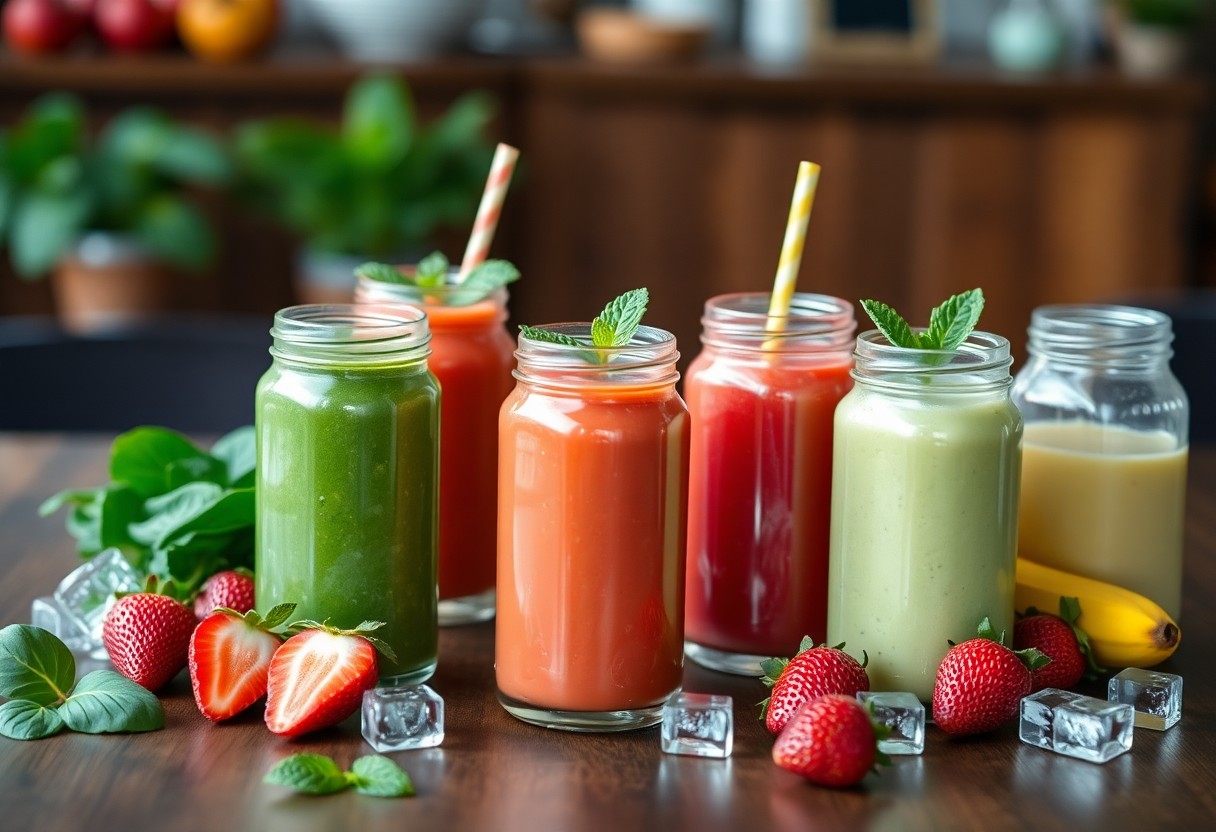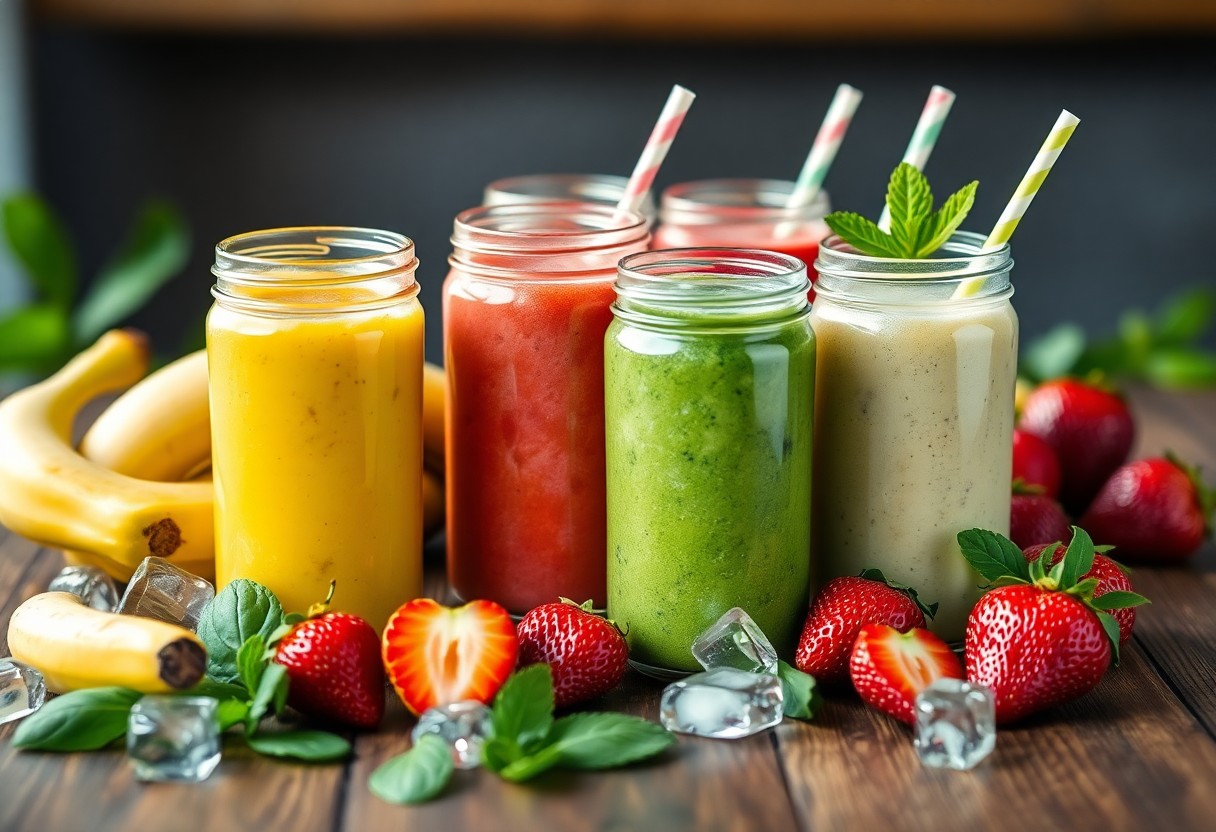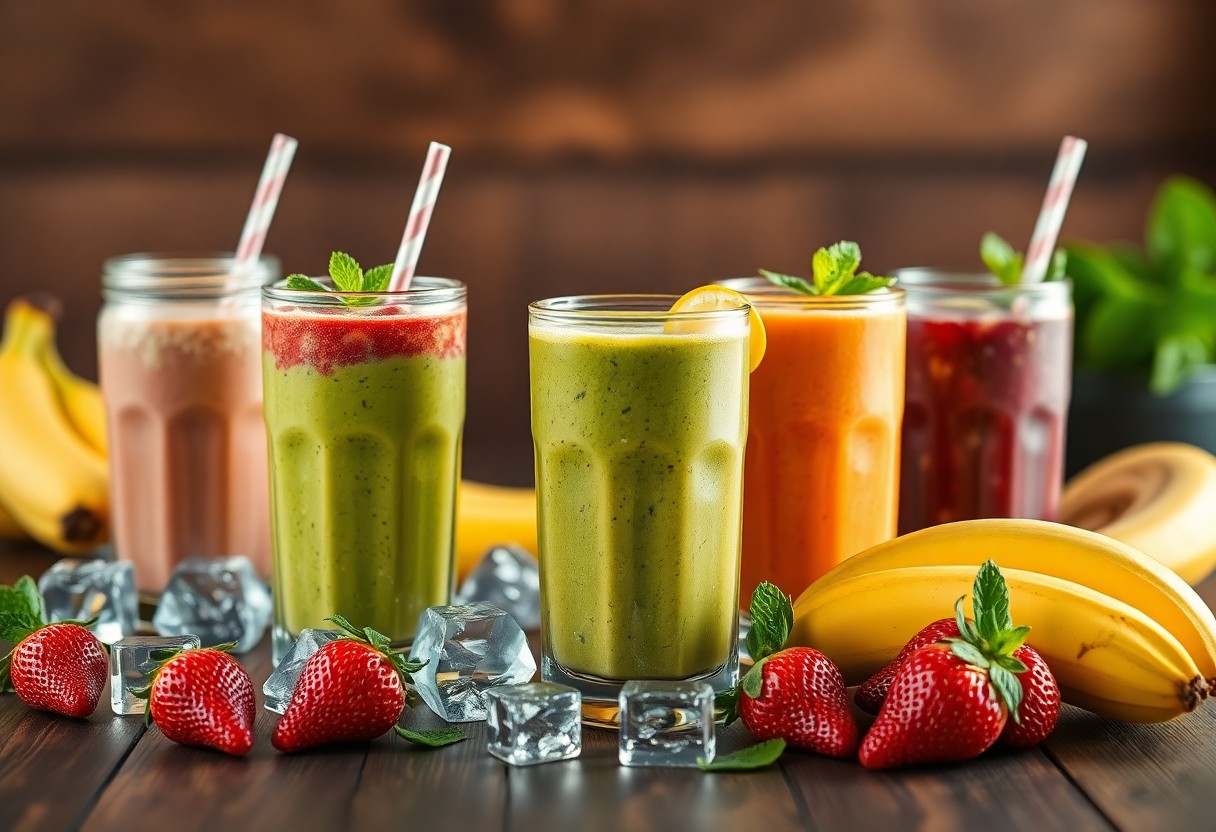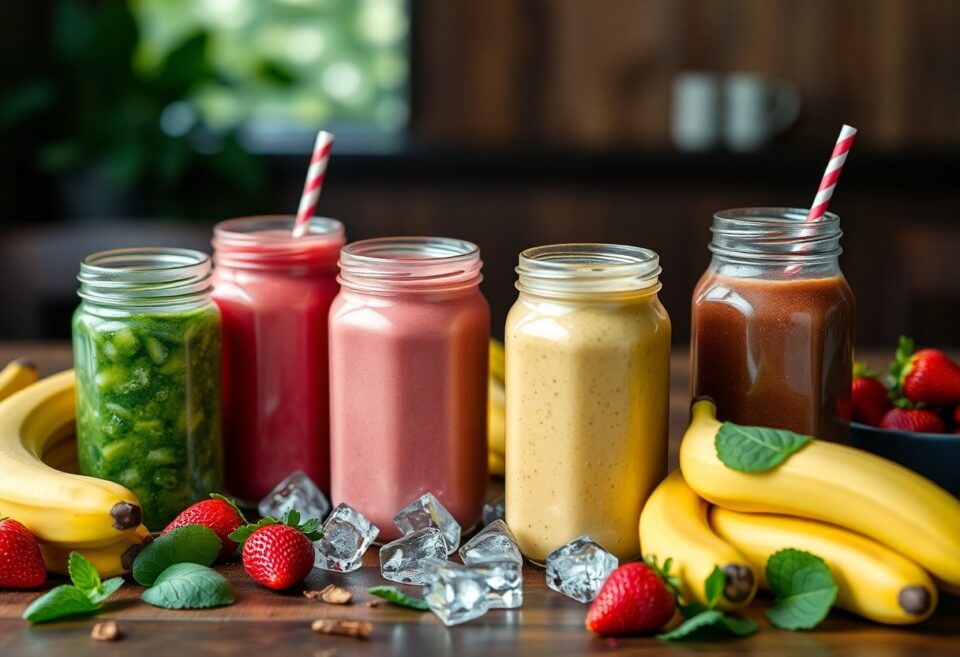Many people overlook the power of a well-crafted smoothie to both nourish and invigorate. In this guide, you’ll discover how to create delicious smoothies packed with important nutrients and antioxidants that can boost your energy and support your overall health. By focusing on balanced ingredients, you’ll avoid common pitfalls like excess sugar and unhealthy additives. Whether you want a quick breakfast or a revitalizing snack, these recipes will help you enjoy flavors that are as refreshing as they are beneficial for your body.

Energizing Morning Boosts
Starting your day with the right smoothie can set a positive tone for hours to come. Smoothies packed with nutrients and balanced flavors help sustain energy levels, supporting focus and productivity. You might find that incorporating a mix of protein, healthy fats, and fiber not only satisfies your morning hunger but also stabilizes your blood sugar. The choice of ingredients subtly impacts how energized you feel, making some blends much more effective than a standard fruit smoothie.
Planning your morning smoothie with purposeful ingredients means prioritizing those that provide a steady release of energy rather than quick spikes followed by crashes. You can experiment with adding sources like Greek yogurt, chia seeds, or nut butters to enhance the nutrient profile. Over time, you’ll likely notice smoother energy flow and less mid-morning fatigue when these power combinations become part of your breakfast routine.
Power-Packed Green Smoothies
Green smoothies might intimidate at first, but when crafted properly, they become nutrient powerhouses that energize without weighing you down. Spinach, kale, and other leafy greens introduce a bounty of vitamins A, K, and C, alongside vital minerals like magnesium and iron, which your body uses to maintain energy production. Pairing these greens with a fruit like banana or apple and a protein source such as almond butter or a scoop of plant-based protein powder creates an ideal combination for lasting vitality.
One tasty option is blending spinach with frozen mango and a tablespoon of flaxseeds, which contributes omega-3 fatty acids to support brain function. Incorporating a splash of coconut water also helps replenish electrolytes, especially if you’re active in the mornings. These smoothies not only feel refreshing but also supply crucial nutrients that your metabolism relies on in the early hours.
Berry Blast Breakfast Drinks
Berries offer an impressive antioxidant profile that combats oxidative stress and inflammation, which can otherwise sap your energy over time. Blueberries, strawberries, and raspberries are rich in vitamin C and fiber, and their vibrant colors indicate the presence of flavonoids associated with improved cognitive function. Combining them with a base of low-fat Greek yogurt or kefir creates a creamy texture and adds beneficial probiotics that support gut health—integral for nutrient absorption and overall wellness.
The tartness of berries balances beautifully with a drizzle of honey or maple syrup for just a touch of natural sweetness. If you’re looking for a smoothie that’s both sweet and satisfying, mixing berries with a small avocado can provide healthy monounsaturated fats that promote brain health and sustained energy release. These drinks pair wonderfully with your morning routine and can become a satisfying breakfast staple.
Additionally, the fiber content in berry blends aids digestion and keeps you feeling fuller longer, reducing the temptation to snack prematurely. These smoothies also allow for easy customization—you can add oats, protein powder, or even a handful of nuts to adjust macros according to your dietary needs. Whether you are rushing out the door or enjoying a leisurely morning, berry-based smoothies offer a sweet, nutrient-dense option that supports both your taste buds and your body’s energy demands.
Creative Combinations for Weight Loss
Low-Calorie Delightful Mixes
Focusing on low-calorie ingredients without sacrificing flavor is key to crafting smoothies that support weight loss goals. Berries, spinach, cucumber, and a splash of coconut water make for a hydrating and nutrient-rich base that clocks in at just about 100 calories per serving. By incorporating fibrous veggies like kale or celery alongside fruits with high water content, you increase satiety while keeping the calorie count low. Adding a wedge of lemon or a few fresh mint leaves can elevate the taste without extra sugar or calories, making your smoothie feel like a treat rather than a diet chore.
Exploring different fruit and vegetable combinations inspires variety, which is crucial for sustainable weight loss. For example, blending green apples with ginger and fresh lime juice creates a zesty, metabolism-friendly drink. You might also try carrot and orange with a hint of turmeric for an anti-inflammatory boost. For more inspiration, explore these 44 smoothie recipes that expertly balance flavor, nutrition, and calorie control.
Protein-Powered Smoothies for Satiety
Adding protein to your smoothies can make a notable difference in controlling hunger and reducing overall calorie intake throughout the day. Greek yogurt, silken tofu, or a scoop of high-quality plant-based protein powder help stabilize blood sugar levels and extend the feeling of fullness after consuming the drink. For weight loss, aim for at least 15-20 grams of protein per smoothie to effectively curb the urge to snack between meals.
Incorporating ingredients like chia seeds or nut butters not only adds a protein punch but also delivers healthy fats that slow digestion, further promoting satiety. Combining protein with fiber-rich fruits or vegetables enhances this effect, supporting your energy levels and enhancing muscle repair if you pair your smoothie habit with regular exercise.
Protein-powered smoothies are particularly useful if you struggle with afternoon energy slumps or find yourself reaching for less healthy snacks. Thoughtful combinations that prioritize protein and fiber can transform your smoothie into a powerful meal replacement or a nutritious pre- or post-workout fuel. The diversity in protein sources—from dairy to plant-based options—ensures you can tailor recipes to your dietary preferences without sacrificing satiety or enjoyment.

Nutrient-Dense Snack Alternatives
When looking for snack options that not only satisfy hunger but also fuel your body, smoothies offer an incredible advantage. Instead of reaching for processed snacks that provide empty calories, you can blend together ingredients packed with vitamins, minerals, and antioxidants. For instance, incorporating leafy greens like spinach or kale with a blend of berries boosts your antioxidant intake significantly, aiding in cellular repair and immune support. Combining healthy fats from avocado or nut butters contributes to sustained energy release, while Greek yogurt or plant-based protein powders enhance muscle recovery and satiety.
One standout recipe that exemplifies this balance is the World’s Easiest Refreshing Smoothie Recipe. This blend simplifies prepping nutrient-dense snacks by focusing on minimal ingredients that deliver maximum nutrients, suiting your busy lifestyle without compromising health benefits. By experimenting with variations of this basic formula, you can tailor snacks to fit your energy needs throughout the day while ensuring your body stays nourished and refreshed.
Post-Workout Recovery Blends
After intense physical activity, your muscles and glycogen stores require replenishment. Smoothies designed with recovery in mind often contain a mix of carbohydrates and proteins in a roughly 3:1 ratio. Adding ingredients like banana, oats, and honey offers fast-digesting carbs that quickly restore energy, while whey or pea protein powders facilitate muscle protein synthesis. Including anti-inflammatory elements such as turmeric or ginger minimizes post-exercise soreness, helping you recover quicker and attain consistent performance improvements.
Hydration is equally necessary post-workout. Blender-friendly liquids like coconut water or almond milk provide electrolytes that prevent cramping and dehydration. You might also consider blending in a handful of frozen berries rich in vitamin C and flavonoids, which support immune function and reduce oxidative stress from workout-induced free radicals. Combining these components transforms your smoothie into a powerful recovery tool that aids your body in rebuilding stronger after every session.
Superfood Smoothies for Optimal Health
Superfoods like chia seeds, spirulina, maca root, and acai bring concentrated amounts of nutrients with distinct health-promoting properties. For example, chia seeds are loaded with omega-3 fatty acids and soluble fiber, which improve heart health and digestive regularity. Spirulina is considered a complete protein, delivering necessary amino acids alongside antioxidants that support detoxification. Blending these into your smoothie creates a nutrient powderhouse capable of boosting energy, enhancing mental clarity, and supporting overall resilience against chronic diseases.
Pairing superfoods with fresh fruits and vegetables maximizes nutrient absorption and flavor balance. For instance, adding a bit of pineapple or mango not only sweetens but provides digestive enzymes like bromelain, improving gut health. Integrating leafy greens or cucumber increases hydration and provides vitamins A and K. These combinations make superfood smoothies a versatile, delicious addition to your daily diet, promoting longevity and vibrant well-being.
To make the most out of superfood smoothies, focus on variety and balance in your ingredients. Incorporating a spectrum of colors from the produce you select ensures you’re getting a broad range of phytochemicals and micronutrients. You can rotate different superfood powders and seeds to mitigate potential nutrient imbalances and maintain a rich nutrient profile. Such mindful crafting of smoothies supports your body’s requirements comprehensively, leaving you energized and ready to face daily challenges.

Seasonal Sensations to Keep You Cool
Refreshing Summer Smoothies
Summer calls for vibrant blends that not only hydrate but also deliver a refreshing burst of flavor. You can experiment with ingredients like watermelon, cucumber, and mint—each pack a high water content making them excellent for cooling off. For instance, a watermelon-mint smoothie combined with lime juice can provide an invigorating zing with just about 50 calories per serving, ideal for a midday revitalizer without the guilt. Adding a handful of spinach will boost fiber and vitamins without compromising the crisp taste.
Consider how tropical fruits such as pineapple and mango add natural sweetness, which helps reduce the need for added sugars. A mango-pineapple smoothie with coconut water not only replenishes electrolytes but also delivers antioxidants like vitamin C, which supports your immune system during those hot and active days. Using ice or frozen fruits can further enhance the chill factor, giving you that perfectly frosty texture you desire.
Cozy Winter Warmers
While smoothies are often associated with cool treats, winter-friendly smoothies provide a comforting alternative packed with nutrients. You might try blending warm spices like cinnamon and nutmeg with root vegetables such as sweet potato or pumpkin, which offer beta-carotene and fiber. A steamed carrot and ginger smoothie served warm can boost circulation and provide an anti-inflammatory effect during colder months. Including protein-rich ingredients like Greek yogurt or nut butters makes these blends more satisfying and energizing.
Incorporating warming components such as turmeric not only imparts a golden hue but also helps reduce winter inflammation, which many find beneficial during the dry and chilly season. Combining the turmeric with banana and a hint of black pepper enhances absorption of curcumin, the active compound in turmeric, providing added health benefits. These cozy concoctions gently nurture your body while supporting a healthy metabolism in the colder days.
Cozy winter smoothies offer a unique way to merge comfort with nourishment, blending ingredients that warm your body from the inside out. Experimenting with diverse textures and spices can transform your smoothie routine into a nourishing ritual that complements the season’s slower pace.
Innovations in Smoothie Preparation
Exploring beyond traditional fruit blends unlocks new flavors and health benefits that elevate your smoothie experience. Integrating unexpected ingredients not only enhances the taste but also maximizes nutritional content, letting you tailor each drink to your unique wellness goals. You might experiment with various textures by incorporating nut butters or seeds, which add creaminess and a satisfying bite, turning your smoothie into a more filling and sustaining meal.
Another innovation involves the use of advanced blending techniques that preserve the integrity of delicate vitamins and enzymes. For instance, using a low-speed blender helps retain the natural enzymes often destroyed by high-speed machines. Leveraging these modern tools and ingredient combinations will elevate your daily smoothie into a gourmet and nourishing ritual. For a selection of inspired ideas, explore detailed Healthy Breakfast Smoothies Recipe for more inspiration.
Advanced Ingredients: Spices and Herbs
Incorporating spices and herbs such as turmeric, cinnamon, and fresh ginger not only spices up your smoothie but also infuses potent antioxidants that support your immune system and reduce inflammation. Turmeric’s active compound, curcumin, has been linked to a variety of health benefits including enhanced brain function and reduced risk of chronic diseases. Meanwhile, cinnamon adds a natural sweetness while helping regulate blood sugar levels, a helpful element if you want to manage energy dips throughout your day.
You can also experiment with fresh herbs like mint and basil to introduce vibrant notes that complement the fruit’s brightness. Mint provides a cooling sensation and may help soothe digestion, while basil introduces subtle sweetness and antibacterial properties. Below is a quick reference table detailing some of these advanced ingredients and their principal health benefits:
| Ingredient | Health Benefits |
|---|---|
| Turmeric | Anti-inflammatory, antioxidant, supports brain health |
| Cinnamon | Regulates blood sugar, natural sweetness, anti-inflammatory |
| Ginger | Aids digestion, reduces nausea, anti-inflammatory |
| Mint | Soothes stomach, adds fresh flavor, antibacterial |
| Basil | Antibacterial, adds sweetness, supports immune function |
Unique Add-Ins: Nutritional Boosters
You can amplify your smoothie’s nutrition by adding powerhouse ingredients like spirulina, maca powder, or chia seeds. Spirulina, a blue-green algae, supplies high amounts of protein and B vitamins, known for boosting energy and endurance. Maca powder is an adaptogen that might help balance hormones and enhance mood, making your smoothie ideal for mental clarity and stress relief. Chia seeds pack fiber and omega-3 fatty acids that assist in digestion and cardiovascular health.
Combining these nutritional boosters with the natural sweetness and texture from fruits results in a nutrient-dense blend that energizes and satisfies. Mixing a teaspoon of spirulina and chia seeds with fresh fruit and leafy greens transforms a simple smoothie into a potent meal replacement or workout recovery drink.
Exploring unique add-ins like cacao nibs, bee pollen, or collagen peptides also creates varied textures and amplifies the health benefits. Each ingredient contributes specific functional benefits that help you customize the smoothie according to your dietary requirements or energy needs. Selecting from these options allows you to consistently keep your smoothies not only delicious but also a dynamic part of your health regimen.
Final Thoughts
Balancing Flavor and Nutrition
Creating a smoothie that tastes delicious while packing a nutritional punch is a skill worth developing. Incorporating a mix of fruits, vegetables, and a source of protein or healthy fats can enhance both the flavor complexity and health benefits. For instance, combining antioxidant-rich berries with creamy avocado not only adds creaminess but also provides necessary omega-3 fatty acids that support brain health. You might experiment by adding a tablespoon of chia seeds or flaxseeds to boost fiber content, which aids digestion and promotes satiety.
Adapting Recipes to Your Lifestyle
Your personal preferences and dietary goals should guide the customization of smoothie recipes. If you lead an active lifestyle, incorporating ingredients like Greek yogurt or plant-based protein powders can help with muscle recovery and sustained energy. Conversely, if weight management is a priority, focusing on low-sugar ingredients such as leafy greens, cucumbers, and unsweetened nut milks can reduce calorie intake without sacrificing refreshment. By tracking how different combinations affect your energy levels and well-being, you can fine-tune your approach to make smoothies an effective part of your daily routine.
FAQ
Q: What are some basic ingredients I should include in a healthy smoothie?
A: A healthy smoothie typically includes a combination of fresh or frozen fruits, leafy greens like spinach or kale, a liquid base such as water, almond milk, or coconut water, and a source of protein such as Greek yogurt, protein powder, or nut butter. Adding fiber-rich ingredients like chia seeds or flaxseeds can also enhance the nutritional value.
Q: How can I make a smoothie more refreshing for hot weather?
A: To create a more refreshing smoothie, use frozen fruits instead of fresh to provide a chilled texture. Incorporate ingredients with high water content like cucumber, watermelon, or citrus fruits. Adding a handful of fresh mint or a splash of lime juice can also invigorate the flavor and increase the thirst-quenching effect.
Q: Are smoothies a good option for weight management?
A: Smoothies can support weight management when made with wholesome, nutrient-dense ingredients and controlled portions. Avoid adding excessive sweeteners or high-calorie ingredients. Focus on incorporating fiber, protein, and healthy fats to promote satiety and maintain balanced energy levels throughout the day.
Q: Can I prepare smoothie ingredients in advance?
A: Yes, you can prepare smoothie packs by pre-portioning fruits, vegetables, and other mix-ins into freezer bags. Store these packs in the freezer and blend with your preferred liquid base when ready. This method saves time and helps maintain ingredient freshness, making it convenient for busy mornings.
Q: What are some ways to add protein to my smoothie without altering the taste too much?
A: You can add protein through mild-tasting options such as plain Greek yogurt, silken tofu, or a scoop of unflavored or vanilla protein powder. Nut butters like almond or peanut butter add protein as well, but may affect flavor slightly. Experimenting with small amounts helps find the right balance for your palate.
Q: How can I reduce sugar content in fruit-based smoothies?
A: To lower sugar levels, choose fruits with lower natural sugar content like berries, green apples, or avocados. Avoid adding sweeteners such as honey, syrup, or sweetened yogurt. Adding vegetables and protein sources will also balance the overall sweetness and create a more nutrient-rich smoothie.
Q: What equipment is best for making smooth and creamy smoothies?
A: A high-powered blender is ideal for achieving smooth and creamy textures, especially when blending fibrous vegetables, nuts, or frozen ingredients. Blenders with strong motors and sharp blades ensure even blending and reduce chunkiness. If you don’t have a high-powered blender, soaking nuts or seeds beforehand can help improve consistency.
